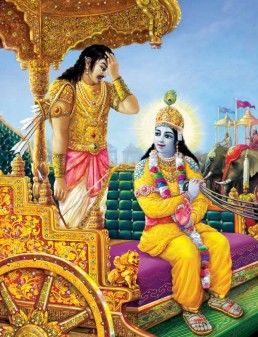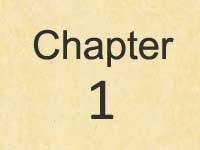
अर्जुनविषादयोग
Arjuna Vishada Yoga - Yoga of despondency of Arjuna
Arjuna the great warrior is overpowered by grief and delusion born out of a sense of attachment to his kith and kin. In his delusory state, he makes several fallacious arguments to support his decision not to fight. This sets the stage for the Lord’s teaching which comprises the rest of the Gita.Below are the main themes of Chapter 1:
Verses 1 - 20
Description of the armies and the preparations for the battle.
Verses 21 - 25
Arjuna’s chariot driven to the middle of the battlefield amidst the two armies.
Verses 26 - 28
Arjuna's change of mind, leading to attachment (rāga)
Verses 25 - 34
Arjuna’s grief on seeing the enormity of the task he is about to undertake (śoka)
Verses 35 - 47
Arjuna’s delusion which stems from his ignorance about the true nature of oneself (moha)
Chapter 1 - 47 Verses
Chapter 1 - 47 Verses
Commentary by Swami Paramarthananda
Background
The epic battle of Mahābhārata, fought between the Pāṇḍavas and Kauravas is the scenario in which the Gītā-teaching is imparted. Arjuna, the Pāṇḍava, discovers the problem of saṃsāra in the battlefield. He surrenders to Lord Krishna seeking a solution. Then follows the great teaching.
In order to attain the wisdom that permeates the Gītā one should go through the following phases in life:
- One should discover the problem of saṃsāra, for which Gītā happens to be a solution. Unless one discovers the disease, one will not seek medicine.
- One should become possessed by a sincere longing (tīvramumukṣā) for freedom from saṃsāra. This alone can lead to committed and fruitful pursuit.
- One should realize that one cannot solve this problem independently. The maximum that one can do, as a limited human being, is a rearrangement or a reshaping of the problem.
- One should surrender to a Guru seeking his guidance. When surrender to the Guru happens, the ground is prepared for the Gītā-teaching to take place.
The entire first chapter and the first part of the second chapter are devoted to show these developments.
The problem of saṃsāra
As shown in the first chapter, the problem of saṃsāra can be said to be the problem of attachment (kṛpā or rāga), grief (śoka or viṣāda) and delusion (moha). When one is not happy with oneself, one has to seek external aids. This leads to dependence and attachment. Since the conditions of the depended factors are unpredictable, the very peace of mind of that person is in trouble. A disturbed mind can make only faulty judgments complicating matters further. Thus a vicious cycle is created. This, in short, is the problem of saṃsāra.
Verse details
Coming to the text, we find, in the first twenty verses, a vivid description of the armies arrayed for battle. After a brief instruction of Duryodhana to his commanders, Bhīṣma, Lord Krishna, Arjuna, and others blow their conches, signaling the commencement of the battle (1 to 20).
At this fateful moment, Arjuna commands Lord Krishna, his charioteer, to place the chariot in the middle of the army to scrutinize the enemy forces. The mischievous Lord brings the chariot in front of Bhīṣma and Droṇa and asks Arjuna to survey the army (21 to 25).
(Till now Arjuna was convinced that his cousins are unrighteous and he, as a kṣatriya, has to fight the battle to establish righteousness.)
In a moment of weakness, Arjuna slips from reason to relation. Instead of seeing the violators of dharma, he sees his beloved kith and kin. Naturally, Arjuna is overpowered by attachment. Then follow the twin offshoots of attachment viz. grief and delusion (26 to 30).
In the next five verses, we see Arjuna expressing his intense grief which shakes him completely. This indicates the extent of his attachment.
Veiled by attachment, his discriminating power becomes inoperative and he commits a series of false judgments. Interestingly enough, Arjuna even quotes the scriptures to support his unreasonable stand. Thus, Arjuna gets caught up in delusion which is depicted from the 36th verse up to the end of the chapter (36 to 47).
In this way, Arjuna finds himself in the deep sea of attachment, sorrow and delusion (rāga, śoka, moha). Arjuna sincerely wants to get out of this problem. He thinks that solution is to drop the battle. But, one corner of his mind is not convinced by this. At the same time, he has not realized that the problem is too deep for him to solve independently. Hence he doesn’t surrender to Krishna either. Thus caught up in a dilemma, Arjuna sits back on the chariot sorrowfully.
The main topics of this chapter are:
- Description of the armies and the preparations: 1 to 20
- Arjuna’s chariot driven to the middle of the armies: 21 to 25
- Arjuna’s change of mind leading to attachment (rāga): 26 to 28
- Arjuna’s grief (śoka): 25 to 34
- Arjuna’s delusion (moha): 35 to 47
Since Arjuna’s grief is the main topic, this chapter is aptly called Arjunaviṣādayoga.

